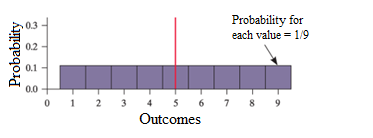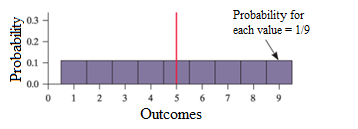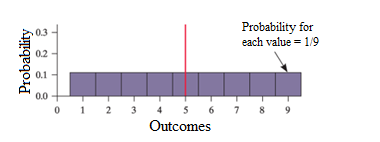
Concept explainers
(a)
Probability for the
(a)
Answer to Problem 21E
Probability,
According to Benford’s law,
Probability,
If the first digit proportion greater than 6 is closer to 0.3333 instead of 0.155, then the expense report is false.
Explanation of Solution
Given information:
Histogram representing the first digit Y (from 0 to 9) of a randomly selected expense amount:

Calculations:
Two events are mutually exclusive, if the events cannot occur at the same time.

We have
The probability for each event is
For
For
For
We know that
It is not possible for the first digit to be two different digits at the same time.
Thus,
The events are mutually exclusive.
Then
Apply the addition rule for mutually exclusive events:
According to Benford’s law,

Probabilities from the table,
We have
For
For
For
We know that
It is not possible for the first digit to be two different digits at the same time.
Thus,
The events are mutually exclusive.
Then
Apply the addition rule for mutually exclusive events:
If the first digit proportion greater than 6 is closer to 0.3333 instead of 0.155, then the expense report is false.
(b)
(b)
Answer to Problem 21E
The distribution is symmetric and the mean lies in the middle of the distribution, which means mean needs to lie at 5.
Explanation of Solution
Given information:
Histogram representing the first digit Y (from 0 to 9) of a randomly selected expense amount:

Calculations:
The
Thus,
Now,
Note that
The expected value is 5 in the histogram.
We came to know that
The distribution is symmetric and the mean lies exactly in the middle of the distribution.
This implies
The mean needs to lie at 5.
(c)
Information according to Benford’s law is used to detect a fake expense report.
(c)
Answer to Problem 21E
If the mean of all first digits in an expense report is closer to 5 instead of 3.441, then the expense report is false.
Explanation of Solution
Given information:
Histogram representing the first digit Y (from 0 to 9) of a randomly selected expense amount:

According to Benford’s law,
Expected value (or mean),
Calculations:
From Part (b),
We have
The mean of uniform distribution is 5.
In this Part,
The mean according to Benford’s law is 3.441.
If the mean of all digits in an expense report is closer to 5 instead of 3.441, then the expense report is false.
Thus,
If we obtain an expense report with a mean of first digits close to 5 instead of 3.441,
Then
We will assume that the expense report is fake.
Chapter 6 Solutions
PRACTICE OF STATISTICS F/AP EXAM
Additional Math Textbook Solutions
A First Course in Probability (10th Edition)
Elementary Statistics
Introductory Statistics
Elementary Statistics: Picturing the World (7th Edition)
Calculus: Early Transcendentals (2nd Edition)
- A marketing agency wants to determine whether different advertising platforms generate significantly different levels of customer engagement. The agency measures the average number of daily clicks on ads for three platforms: Social Media, Search Engines, and Email Campaigns. The agency collects data on daily clicks for each platform over a 10-day period and wants to test whether there is a statistically significant difference in the mean number of daily clicks among these platforms. Conduct ANOVA test. You can provide your answer by inserting a text box and the answer must include: also please provide a step by on getting the answers in excel Null hypothesis, Alternative hypothesis, Show answer (output table/summary table), and Conclusion based on the P value.arrow_forwardA company found that the daily sales revenue of its flagship product follows a normal distribution with a mean of $4500 and a standard deviation of $450. The company defines a "high-sales day" that is, any day with sales exceeding $4800. please provide a step by step on how to get the answers Q: What percentage of days can the company expect to have "high-sales days" or sales greater than $4800? Q: What is the sales revenue threshold for the bottom 10% of days? (please note that 10% refers to the probability/area under bell curve towards the lower tail of bell curve) Provide answers in the yellow cellsarrow_forwardBusiness Discussarrow_forward
 MATLAB: An Introduction with ApplicationsStatisticsISBN:9781119256830Author:Amos GilatPublisher:John Wiley & Sons Inc
MATLAB: An Introduction with ApplicationsStatisticsISBN:9781119256830Author:Amos GilatPublisher:John Wiley & Sons Inc Probability and Statistics for Engineering and th...StatisticsISBN:9781305251809Author:Jay L. DevorePublisher:Cengage Learning
Probability and Statistics for Engineering and th...StatisticsISBN:9781305251809Author:Jay L. DevorePublisher:Cengage Learning Statistics for The Behavioral Sciences (MindTap C...StatisticsISBN:9781305504912Author:Frederick J Gravetter, Larry B. WallnauPublisher:Cengage Learning
Statistics for The Behavioral Sciences (MindTap C...StatisticsISBN:9781305504912Author:Frederick J Gravetter, Larry B. WallnauPublisher:Cengage Learning Elementary Statistics: Picturing the World (7th E...StatisticsISBN:9780134683416Author:Ron Larson, Betsy FarberPublisher:PEARSON
Elementary Statistics: Picturing the World (7th E...StatisticsISBN:9780134683416Author:Ron Larson, Betsy FarberPublisher:PEARSON The Basic Practice of StatisticsStatisticsISBN:9781319042578Author:David S. Moore, William I. Notz, Michael A. FlignerPublisher:W. H. Freeman
The Basic Practice of StatisticsStatisticsISBN:9781319042578Author:David S. Moore, William I. Notz, Michael A. FlignerPublisher:W. H. Freeman Introduction to the Practice of StatisticsStatisticsISBN:9781319013387Author:David S. Moore, George P. McCabe, Bruce A. CraigPublisher:W. H. Freeman
Introduction to the Practice of StatisticsStatisticsISBN:9781319013387Author:David S. Moore, George P. McCabe, Bruce A. CraigPublisher:W. H. Freeman





